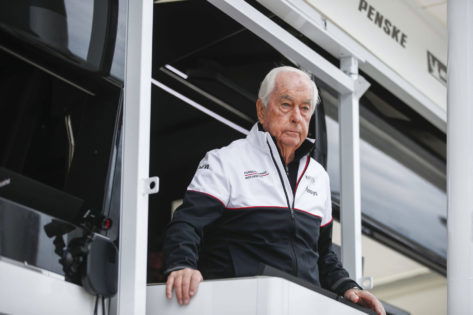Kyle Larson led 441 of 500 laps to snag a win at Bristol Motor Speedway. While some might see this as dominant performance, those who have been watching short-track racing know this is becoming the new normal. Track position is the king in the Next Gen era, while the garage demands changes to the superspeedway package, priority needs to be given to short-track racing. This is what Ryan Blaney from Team Penske had to say after last weekend’s All-Star race, and the racing on the iconic track did have some positives.
Take out the format and the gimmicks of the promoter’s caution, the track did produce good racing. Joey Logano led 139 laps and looked like the dominant car until Christopher flexed his muscle. Late-race strategy and two tires led to a scintillating battle between him and Logano, and while Bell wasn’t the driver leading the most laps, he found a way to get past the No. 22 Ford, and watching the race many left with the feeling that this was perhaps the best short track race they’ve witnessed in the Next Gen era.
Yet Blaney wasn’t entirely sold on the hype, and he had his reasons. Remember last year, we had the tire wear race at Bristol where Denny Hamlin managed to save his tires to grab a win? That only happened once, and while NASCAR experimented with the tires, nothing moved; the racing remained the same. NASCAR canceled the option tires that looked promising for the rest of the year, and this has got Blaney worried.
Short track package cannot be ignored
Ryan Blaney shared his take on the improvements that are needed for the Next Gen car to improve the on-track racing. “I really do think it definitely needs to keep continuing to improve. And I hope NASCAR continues to keep looking at that — how we can get these cars a little bit better in dirty air. That’s across everywhere. … But I think it just shows up more on the short tracks because a lot of times there’s not as much room as the mile-and-a-half, where it’s wide and things like that, where you can search for clean air.”
Now the driver of the No. 12 car knows a thing or two about making race-winning passes. He has two wins at Martinsville Raceway in the do-or-die playoff race with this car. Last year, he also won at Iowa, along with another five top 5 finishes at tracks like Bristol and a dirt race at Martinsville. So he knows how tough it is to make a pass on the lead car. Blaney went on to speak about the problem, highlighting how this problem never persisted in the older generation.
“I really wish this car — No. 1, we always want cars that follow better directly behind cars. You’re never going to be perfect whatever series it is, what year it is. The cars are always gonna be worse in dirty air directly following. With the old car, if somebody missed the bottom by three inches, it would do a lot for the trailing car. This car, it feels like they gotta miss the bottom by half a car width plus, two-thirds of a car width for it to do anything.” He added.
Very few short tracks offer multi-groove racing, so the only way to make a pass on the car ahead is through the inside lane. But unlike the Xfinity cars, the Next Gen machine isn’t aero-sensitive. The side draft isn’t a huge factor, the lead car barely gets loose under the heavy pressure. This is the reason we see bump and run becoming a tool for these drivers, as there’s very little to work with the car. Even if you make it to the rear bumper of the car ahead, they can keep throwing the blocks, leaving pit road and restarts as the only options to make any gains.
“I hope they continue to look at it, don’t just live with it.”
After a successful All-Star Race at @NWBSpeedway, Ryan @Blaney says there is still room for improvement in the short track racing package.
More–> https://t.co/MKhd9eLpQA pic.twitter.com/TFK6GO0Bsn
— SiriusXM NASCAR Radio (Ch. 90) (@SiriusXMNASCAR) May 21, 2025
“You just need three inches, a little bit of the gap from the bottom lane or to the apron and that really helps the rear car turn. And I think if you do that, then you’ll be able to get the guys loose on the left rear quarter pannel. We used to be able to do that a lot, now it’s hard to do. It’s really hard to get there in general. So I hope they continue to look at it,” Blaney concluded.
Well, NASCAR doesn’t seem to be invested in the tire experiment with Goodyear. They tried it, and the results were minimal. So, where does the solution come from? And the simple answer that Denny Hamlin has been screaming for some time now is an increase in horsepower. Surprisingly, NASCAR is also considering making this change, finally.
More power to the engine could be the key to solving the issues with the Next Gen car
“We just got to get with the drivers, get in a room and figure out what do you fight? Why can’t you pass? And then come up with some remedies of how we can change this.” This was Hamlin’s proposal to solve the woes on the Next Gen car. With short ovals becoming a snooze-fest, and superspeedway racing turning into a fuel-mileage execution and demolition derby, something had to change. And finally, it looks like NASCAR is ready to sit at the table and discuss the solution with the teams and drivers.
NASCAR’s Mike Forde, sharing inside news on Hauler Talk, stated, “You hear some levels of 900 or 1,000 horsepower. I don’t know if that’s… it’s not on the table, just because of the cost. But there’s some conversation of, ‘Can you go up to 750?’ And that’s something that, well, I’m sure we’ll discuss with the drivers too.” But what exactly will more power do, or change?
With more power, the drivers will have to use more brake and less throttle. You won’t see drivers going wide open on short tracks with a bump in power. Essentially, the power will make the car harder to drive, and attempts to push the limits could lead to crashes and wrecks. The current output from the engine stands at 670 bhp, and reports state that 750 bhp is what NASCAR would be willing to consider. It is worth noting that there’s no promise or commitment from NASCAR’s side, and we could see the current problem persist for some time.
The post Roger Penske’s Short Track Maestro Makes His Feelings Known on NASCAR’s Problematic Next-Gen Package appeared first on EssentiallySports.



